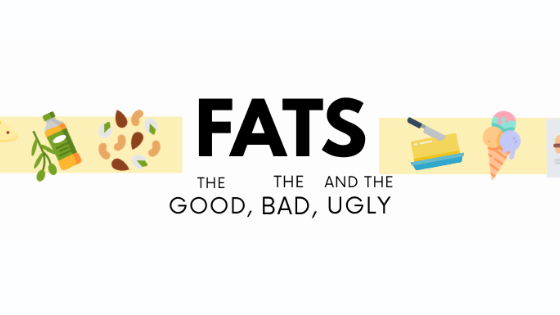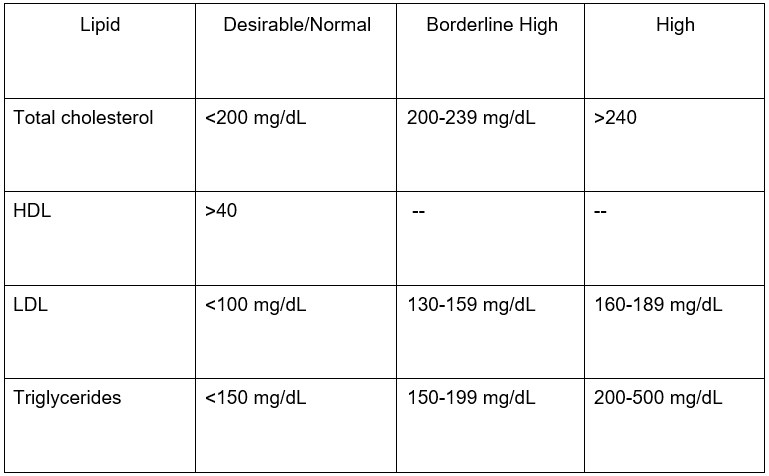Fats: The Good, the Bad and the Ugly—Part 4

Cholesterol is a waxy, fat-like substance that is not inherently bad. Our bodies need cholesterol to build cells, produce hormones, and make substances that help digest food; however, too much cholesterol can lead to problems. Your body, specifically the liver, produces all the cholesterol your body needs. The other source of cholesterol is animal foods, such as meat, poultry, dairy, as well as some tropical oils. There are two types of cholesterol:
● Low density lipoprotein (LDL): considered the “bad” cholesterol since it contributes to fatty buildup in arteries. With LDL, lower values on your bloodwork tests are better.
● High density lipoprotein (HDL): considered the “good” cholesterol since it helps remove the “bad” LDL cholesterol away from the arteries and back to the liver, so it can be removed from the body. With HDL, higher values in your blood are better.
Diet and physical activity are two factors that affect cholesterol levels that you can control. Foods high in saturated and trans fats (like animal foods, tropical oils, and baked goods) cause the body to produce more cholesterol. For some people, this is what pushes cholesterol levels from normal to high. Eat a heart-healthy diet and engage in moderate-intensity physical activity to support healthy cholesterol levels.
Focus on eating foods low in saturated and trans fats, such as:
○ Fruits and vegetables
○ Whole grains
○ Low-fat dairy products
○ Poultry without skin and other lean meats
○ Red meat and pork labeled “loin” and “round” (these cuts usually have the least amount of fat)
○ Non-fried fish
○ Unsalted nuts, seeds, and legumes
○ Non-tropical vegetable oils, like canola, corn, olive or safflower oils
Choose these foods sparingly:
○ Foods with a lot of sodium (salt)
○ Sugar-sweetened beverages
○ Red meats and fatty meats that aren’t trimmed
○ Full-fat dairy products such as whole milk, cream, ice cream, butter, and cheese
○ Baked goods made with saturated and trans fats like donuts, cakes and cookies
○ Foods with “hydrogenated oils” in the ingredients panel
○ Saturated oils like coconut oil, palm oil and palm kernel oil
○ Solid fats like shortening, stick margarine and lard
○ Fried foods
While cholesterol is generally discussed in a negative light, some cholesterol is necessary for normal body functions. Eating a nutritious, well-rounded diet helps raise good cholesterol and lower bad cholesterol. If you struggle to maintain normal cholesterol levels, talk to your doctor about strategies that can help.
Controlling blood lipid/triglyceride levels
Blood lipids refer to fatty substances found in the blood, including cholesterol and triglycerides. In this post we will take a closer look at these two blood lipids as well as discuss how to maintain healthy levels.
Cholesterol is a fat-like substance made by the liver when the body breaks down saturated fats in food. Cholesterol then moves into the bloodstream. There are two types of cholesterol: HDL, the “good” kind, and LDL, the “bad” kind. (Refer to our last blog post “Cholesterol” for more info on that!) Some people have too much cholesterol in their blood and this increases their chances of having a heart attack.
Triglycerides are another type of fat found in the bloodstream that mainly come from food. After you eat, your liver breaks down the fat and any excess calories to triglycerides, which are then released into the bloodstream. These triglycerides can either be used as energy or stored as fat.
Here is a chart that breaks down what blood lipid levels mean:
Lifestyle changes such as diet and exercise can help manage lipid levels.
We love these websites for more tips on changing your lifestyle:
● www.eatrightpro.org/news-center/nutrition-trends/diseases-and-conditions/lifestyle-management-to-reduce-cardiovascular-risk
● www.healthline.com/health/high-cholesterol/lipid-disorder
● www.mayoclinic.org/diseases-conditions/high-blood-cholesterol/in-depth/reduce-cholesterol/art-20045935
● www.heart.org/en/health-topics/cholesterol/prevention-and-treatment-of-high-cholesterol-hyperlipidemia
In terms of making healthy food choices, limit calories from fat to 20-30% of your total caloric intake. For example, if you eat 2,000 calories a day, aim to eat 400-600 calories from fat, which is 44-66 grams of fat. Choose unsaturated fats over saturated or trans fats. Increasing physical activity helps lower LDL while also increasing HDL cholesterol. Aerobic exercises, such as walking, bicycling, and swimming, improves cardiovascular health and helps with weight maintenance. A future post will delve deeper into making heart-healthy choices in the kitchen.